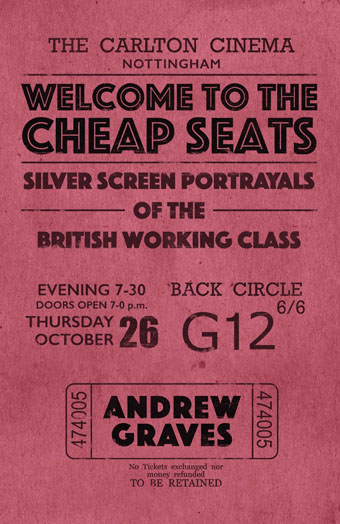|
WELCOME
TO THE CHEAP SEATS: SILVER SCREEN PORTRAYALS OF THE BRITISH WORKING
CLASS
By Andrew Graves
Five Leaves Publications. 184 pages. £9.99. ISBN 978-1-910170-62-5
Reviewed by Jim Burns
Let me make a confession. As a young boy growing up in a northern
industrial town, and living with five others in the usual
two-up-two-down, toilet-in-the-backyard house, I spent as much time
as possible in the local cinemas.
I can’t recall exactly how many there were in total, perhaps
thirteen or fourteen, five of which were in the town-centre, and the
rest scattered around the side and back streets of the outlying
districts.
I watched all the usual things in the mid and late-1940s – Flash
Gordon serials, poverty-row westerns, Old Mother Riley features,
Gracie Fields sing-songs, George Formby silliness – and as my tastes
developed, and more and better films became available in the
early-1950s, I continued to haunt the cinemas. What I have to make
clear is that they were mostly American films that I chose to go to
the cinema for. Looking back sixty or seventy years brings to mind a
jumble of films that I saw and the fact that very few of them were
British. Only the
occasional one like the gritty
It Always Rains on Sunday
surfaces from the mass of mediocre home-grown productions. I come
across them now on YouTube and they admittedly can have a kind of
nostalgic charm, primarily for their documentary value. The shots of
streets with only a few cars, or of the docks when they were busy,
evoke a lost world.
Why did I prefer the Americans? There were some practical reasons.
such as my fascination with westerns. Each week I studied the cinema
listings in the local paper and made a note of where all the
westerns were showing. There were plenty of them in those days, even
if I excluded the weaker ones (Gene Autry, Roy Rogers) that I’d
grown out of. But I
also went to see musicals, thrillers (including some that now appear
in studies of film noir), and comedies. Whatever they were they
certainly appealed to me more than the majority of British-made
films that were circulating then. My liking for films from
But I was conscious of the fact that many of the American films were
more stimulating (direction, lighting, music, scripts) than
virtually anything produced in
Another reason was that most British films seemed to have nothing at
all to do with my life. Did the American films? Perhaps not in a
strictly physical sense, but they seemed to appeal to my state of
mind. I might have been living in a very British working-class
context, still in that old terraced house, with my first job at
sixteen in a cotton mill before I decided that the army was a better
bet, but my thoughts were usually elsewhere.
With that in mind, I didn’t recognise what few representatives of
the working class crept into British films.
Usually relegated to background contributions as gardeners,
taxi-drivers, and other non-descript roles, they did occasionally
also crop up as cheerful female factory workers and chirpy Cockney
corporals when wartime propaganda films were needed. I don’t recall
them having prominent parts in the plots, and serious matters were
the province of smart-suited managers and
carefully-groomed officers. A scene with a soldier arriving
home on leave might show him greeted by a worn-looking wife
surrounded by clamouring kids. A wartime song, “That Lovely
Weekend”, runs through my mind and seems more suited to the delicate
and sometimes doomed love affairs that handsome young officers and
their attractive ladies might experience.
Andrew Graves in his stimulating study of how the working class have
been portrayed on film, is less than enthusiastic about most early
attempts to present accounts of life in the back-streets. He takes a
close look at Love on the
Dole, based on Walter Greenwood’s 1930s novel and set in
There were a couple of early-1950s British films that had a stab at
portraying some aspects of working class life, though
Graves gives a good account of the “new wave” films of the
late-1950s and early-1960s –
Saturday Night and Sunday Morning, The Loneliness of the Long
Distance Runner, Room at the Top, A Taste of Honey, Look Back in
Anger, A Kind of Loving,
This Sporting Life and a few others - and it’s true that they
did seem to be breaking new ground.
I have to admit that I always thought
Room at the Top was about
what I thought of as a working class square, and
Look Back in Anger about
an unlikeable, self-centred bore. It’s significant that their
respective authors – John Braine and John Osborne – became extremely
conservative as they got older.
But they probably always were.
When
Welcome to the Cheap Seats
raises some provocative questions, such as why filmmakers are
attracted to this lumpen-proletariat, if that’s what they are? Do
they seem more “colourful” than the “respectable” working class and
their situations can consequently be exploited for dramatic and
entertainment purposes? It’s certainly a factor that has raised
doubts about TV documentary surveys of people living on benefits,
and angered residents who might rightly claim that those portrayed
are not typical.
|
